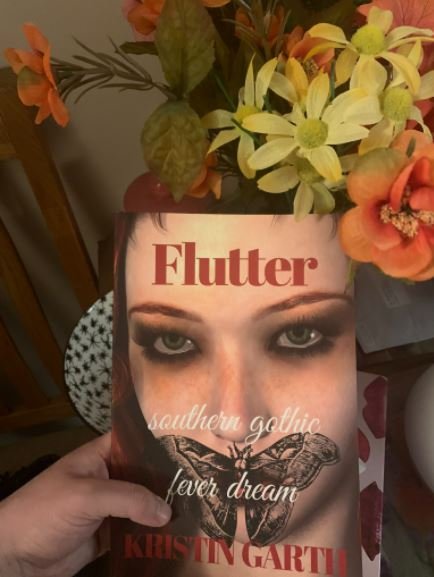Women in Horror Month: Our Bodies Are Horror Stories: Feminist Body Horror and Women’s Health By Madison McSweeney
Our Bodies Are Horror Stories: Feminist Body Horror and Women’s Health By Madison McSweeney
Content warning: This article addresses reproductive health issues and discusses fictional works featuring body horror, sexual abuse, traumatic pregnancy and childbirth, infanticide, gynecological issues, self-injury, and invasive medical tests.
May also contain slight spoilers for literary and cinematic titles named in this document.
Body horror is having a moment. Two of last year’s most talked-about horror movies – Nia DaCosta’s Candyman and Rose Glass’s Saint Maud – use grisly scenes of physical decay and self-mutilation to physicalize the spiritual transformations of their protagonists. And in the literary world, one of the biggest horror hits was Hailey Piper’s Queen of Teeth.
It’s striking – but shouldn’t be surprising - that all of these works were created by women. Body horror, at its heart, is about the terror that comes with losing control of one’s body – a feeling many women know well.
I wanted to explore what body horror means to women in particular, and why so many female creators are drawn to the genre.
Many seminal body horror works see physical transformation as liberating – think Max Renn’s embrace of “the new flesh” in David Cronenberg’s Videodrome. Clive Barker’s queer narratives suggest that new spheres of experience can be accessed through alteration of the body, from Jerry’s transformation into a woman in “The Madonna,” to the gleeful self-mutilations of the Cenobites in Hellraiser. (In his novella Cabal and its film adaptation Nightbreed, Barker uses Aaron Boone’s transition into a shape-shifting monster as a metaphor for coming out). In Re-Animator and From Beyond, Stuart Gordon’s mad scientists see the manipulation of anatomy as an intellectual enterprise, their ability to mold and control human flesh confirmation of their genius.
Female-centric body horror, conversely, tends to mine terror from the loss of agency, lack of understanding, and societal revulsion towards the female body.
It’s perhaps fitting that feminist body horror is medical in nature. Women’s health issues are widely misunderstood, and too many women have to fight the medical system to get proper care. In her 2019 Guardian article “'Women have been woefully neglected': does medical science have a gender problem?”, Nicola Slawson notes that conditions affecting women are often under-researched and under-funded, and that many women struggle to get diagnoses.
Laura Kiesel, writing for the Harvard Health Blog, cites studies showing that women tend to have more severe chronic pain, but are less likely to be prescribed painkillers. Additionally, women are often misdiagnosed because their symptoms differ from the ones experienced by men.
Trans women frequently face difficulties accessing gender-affirming care, often due to lack of information among doctors. In their article “Barriers to Health Care for Transgender Individuals,” Dr. Joshua Safer et al. write: “Transgender treatment is not taught in conventional medical curricula and too few physicians have the requisite knowledge and comfort level.”
Slawson states that the stigma against discussing elements of the female anatomy (and, I would add, sub-par reproductive health education) can also make it difficult for women to advocate for themselves.
This dynamic is portrayed vividly in David Cronenberg’s Dead Ringers. The 1988 film stars Jeremy Irons in a dual role as Elliot and Beverly Mantle, identical twin gynecologists who collude to seduce and take advantage of their patients. One of Cronenberg’s less fantastical works, Dead Ringers nonetheless features his most disturbing body horror sequence: a surgical scene in which a delusional Beverly attempts to operate on a patient he believes to be “deformed.” Of course, she’s not; there are no mutations, transformations, or non-humans to be found. The body horror comes from the powerlessness of the Mantle’s patients, who are at the mercy of these disturbed men.
That theme – the ceding of agency over the most intimate parts of one’s anatomy – is taken to extremes in Hailey Piper’s Queen of Teeth. Piper’s protagonist, Yaya, literally does not own her own body; she was born with a patented genetic mutation and is legally required to submit to invasive regular check-ups. Alone and scared, Yaya goes on the run after she sprouts tentacles from her loins – the first phase of a terrifying metamorphosis that sees her body and mind hijacked by a parasite named Magenta.
Piper’s novel becomes a defiant tale of resistance as Yaya/Magenta falls in love with a rogue operative and wages war against a sinister pharmaceutical company. (It’s basically The Blob as a queer romance). That said, the book also asks complicated questions about consent as Magenta consumes Yaya and other unsuspecting patients to bring more minds into her hive. Finally fighting back against the company that created her, Magenta takes on some of the corporation’s most monstruous qualities.
In my opinion, the most disturbing scene in Queen of Teeth comes at the beginning of the novel, when Yaya discovers her first symptoms – vagina dentata – and has no idea what’s happening to her. “Something was in the way, small and loose, yet hard,” Piper writes. “Hooking her fingers, she did a little prodding, and it fell into her hand…A baby tooth.”
It’s the absence of understanding, rather than simply the loss of control, that distinguishes body horror from other transformation-based horror stories. Vampires and werewolves at least know what they are and what rules they must follow; they have a fighting chance of protecting themselves and the ones they love. Afflicted characters like Yaya have no way of knowing what is wrong with them, how to reverse it, or what they will eventually become.
The unfortunate patient in Dead Ringers suffers from a double lack of information: naturally, she doesn’t understand her reproductive system nearly as well as her gynecologist, but she also doesn’t really know the man operating on her.
The most primal example of this concept – the terror of not understanding one’s body – comes in the opening of Stephen King’s Carrie. Denied basic information about sex and puberty by her fanatical mother, teenage Carrie White gets her first period in a locker room and panics, convinced that the blood flowing down her thighs means something is horribly wrong with her: “I’m bleeding to death!” Carrie screamed, and one blind, searching hand came up and clutched Miss Desjardin’s white shorts. It left a bloody handprint.” (King, 13).
Carrie isn’t technically a body horror story, but I’d be hard-pressed to call that moment of visceral fear anything else.
This scene has echoes in Raw, the 2016 debut from French director Julia Ducournau. Ducournau’s protagonist, aspiring veterinarian Justine, tries meat for the first time and becomes tormented by cannibalistic urges. It’s not until the end of the film that she discovers cannibalism runs in her family, and that their strict vegetarianism was a method of keeping the urges at bay; by attempting to shield her from her nature, Justine’s parents prevented her from taking the precautions (namely, not eating meat) needed to protect herself.
These plots will resonate with women who struggle with conditions like vaginismus and PCOS, common ailments which are all-too-often absent from sex ed curriculums. Many patients suffer for years without treatment because they don’t know their condition exists, and may even blame themselves for their symptoms.
Ducournau’s sophomore effort, the Palme D’Or winning Titane, takes that fear of the unknown to the next level. The film follows Alexia, a female serial killer who goes into hiding, improbably (but believably) passing herself off as the long-missing son of a macho fire chief. The movie plays with ideas of family and gender in interesting ways, but most of its horror is focused on Alexia’s unnatural pregnancy – the result of a bizarre sexual encounter with a car (yes, you read that right).
Unable to seek help without outing herself as both a woman and a murderer, Alexia suffers in silence as her breasts lactate motor oil and a mechanical baby threatens to force its way out of her womb. If her sex makes her vulnerable, it’s the obligation to perform maleness that puts Alexia in true danger.
This script is flipped in British filmmaker Romola Garai’s 2020 film Amulet, in which a man is cursed with a demonic pregnancy as punishment for rape.
The batlike creatures Tomaz births in Amulet are the mirror image of the mystical childbirths in Gwendolyn Kiste’s “Something Borrowed, Something Blue,” the opening story of her collection And Her Smile Will Untether the Universe. Kiste’s protagonist has been pregnant many times and invariably gives birth to birds.
As unsettling as these deliveries are (“A yellow beak, the shape of a crescent moon, pricks through your abdomen, and you know it’s time”), the narrator loves her babies and mourns when they are inevitably shooed out the window or killed by the paramedics who attend to her. The horror in this story lies in the denial of her reproductive rights.
Pregnancy is a source of fear and wonder in body horror. Physical changes and loss of agency are mined for terror, while the experience of childbirth is often transformational.
In the end of “Something Borrowed, Something Blue,” it’s her love for her winged children that inspires the former Mrs. Gardner to free herself from her oppressors: “Any pain they once inflicted inside you is gone, replaced with pure bliss, something far beyond what your husband or the government men or the townspeople could ever understand.” And Titane’s final scene, in which Alexia gives birth in the arms of her surrogate father, sees its sociopathic lead know what Ducournau calls “unconditional love” for the first time in her life.
Tanya Tagaq’s experimental coming of age novel Split Tooth (it would be reductive to call this one horror) uses magical realism to disturbing and sometimes frightening effect, exploring how the body of a young woman is controlled by unknowable forces. In a series of mystical sequences, Tagaq’s teenage narrator is impregnated by the Northern Lights. For a brief moment, the resulting twins restore her bonds with her family and community – until she realizes that her son possesses dangerous powers: “Naja and I watch Savik travel into Uncle’s body to help the sickness grow. I want him to stop but we all know that controlling the foundation of our children’s nature is an act of futility.”
The narrator attempts to save her loved ones by leaving her family home, but realizes that her only option is to kill her son – an act that destroys her daughter and herself. In Tagaq’s book, the unfeeling arctic landscape is as uncontrollable and incomprehensible as the body, using a young girl’s body for its own purpose before leading her to a lonely death.
Isolation and secrecy are key themes in women’s body horror. A common plot point is the gradual deterioration of a character’s health as they try to conceal their symptoms, or as they fight to seek treatment and are not believed. (Sound familiar?)
In Kristin Garth’s poetry collection Flutter: Southern Gothic Fever Dream, a young woman wastes away of what her parents think is scarlet fever; she knows, however, that an erotic encounter with a bee demon has caused her to metamorphose into a flower: “Did he believe you were a bloom? Not rashed / abashed, adolescent doomed”. And “Every Fibre of my Being,” Jennifer Carstens contribution to the Sci-Fi & Scary Twisted Anatomy anthology, sees a woman mutilate herself to prove that her psychosomatic illness is real.
This trope has its roots in feminist Charlotte Perkins Gilman’s 1892 classic “The Yellow Wallpaper” in which a sexist doctor’s strict bedrest order causes a patient to lose her sanity.
If there’s a takeaway from these stories, it’s that ignoring or forsaking our bodies is not an option. We must understand ourselves in order to make ourselves understood. That includes normalizing discussions around women’s health, fighting to ensure that school curriculums cover reproductive health issues, and providing resources when our education system falls short. It also means investing in research into women’s health and ensuring all women have access to healthcare – as well as empowering women to advocate for themselves if they’re not getting the care they need.
If we can shine a light on women’s bodies, maybe they’ll be less fitting settings for horror stories.
#
Madison McSweeney writes horror and fantasy stories from Ottawa, Ontario. She is the author of the horror-comedy The Doom That Came to Mellonville (published by Filthy Loot) and the Short Sharp Shocks! occult horror novelette The Forest Dreams With Teeth (Demain Publishing). Her short fiction and poetry have appeared in anthologies like American Gothic, Zombie Punks F*ck Off, and Wickerpedia.
Twitter: @MMcSw13
Website: www.madisonmcsweeney.com










